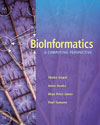 |  Bioinformatics Shuba Gopal,
Rochester Institute of Technology
Anne Haake,
Rochester Institute of Technology
Rhys Price Jones,
George Washington University
Paul Tymann,
Rochester Institute of Technology
Description of Book| Bioinformatic: A Computing Perspective offers well-blended coverage of concepts from both the biological and computational viewpoints.. The authors say in the Preface that what gets them out of bed in the morning is “the idea that we can design an algorithm or computational method that will help us better understand the miracle of life.” It is this passion that led them to write the book.
The work is, in many ways, a standalone text. While aimed at those with some computing background, it contains enough foundational information from both the biological and computing angles that students from either discipline should feel comfortable. Computer science students can learn the biology they need to understand the field from the material in Chapters 2 and 3. Biology students, with some prior exposure to programming concepts, can test the waters with the simpler algorithm exercises in Chapters 4 and 5.
The book is focused on communicating concepts, not on describing tools. As a result, students completing the textbook will have not only a strong foundation and understanding of existing algorithms and computational solutions, but also the ability to apply these methods to new or different biological challenges. One long-running example, human immunodeficiency virus (HIV),is used throughout the text to help keep students focused on material that is often complex and detailed. The threading of a single example system through many topics is meant to enable computing students to ground themselves as they explore the complexities of biology. In turn, an HIV example should allow biology students a chance to return to familiar space even as advanced computing concepts are introduced.
The authors hope the text will enable students to discover how to do bioinformatics for themselves. The exercises are designed to get the students to actually participate in bioinformatics problem-solving rather than simply reporting back to an instructor on the material covered in a given chapter. This is a consistent theme of all the exercises but is especially predominant in the motivation for Chapter 9. In Chapter 9, students have to do more: they must go out and discover concepts, identify existing approaches, and then propose their own solutions to specific biological challenges. In other words, the focus of this text is on creating a new generation of bioinformatics scientists, not just students who are savvy about existing tools and methods.
|
|



 2009 McGraw-Hill Higher Education
2009 McGraw-Hill Higher Education

 2009 McGraw-Hill Higher Education
2009 McGraw-Hill Higher Education